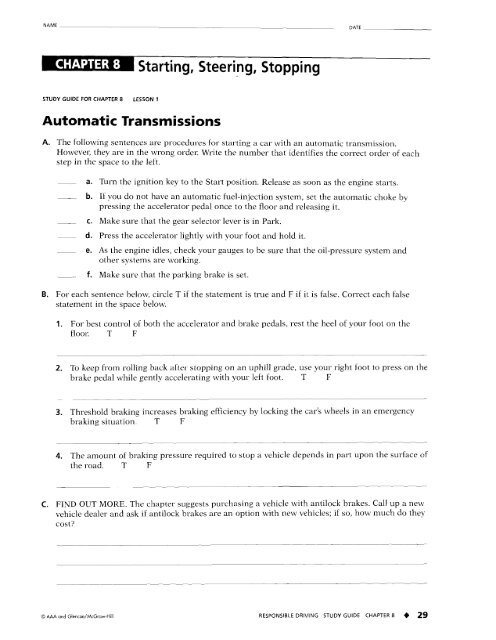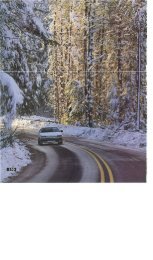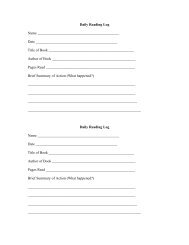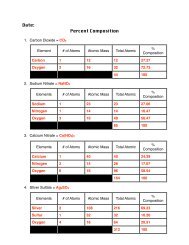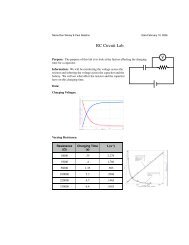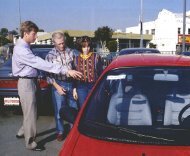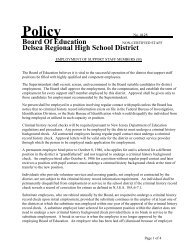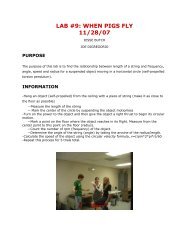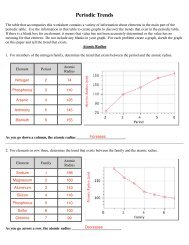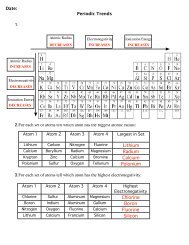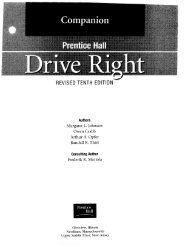Chapter 8, Lesson 1 - Delsea
Chapter 8, Lesson 1 - Delsea
Chapter 8, Lesson 1 - Delsea
- No tags were found...
Create successful ePaper yourself
Turn your PDF publications into a flip-book with our unique Google optimized e-Paper software.
NAMEDATESTUDY GUIDE FOR CHAPTER 8 LESSON 1Automatic TransmissionsA. The following sentences are procedures for starting a car with an automatic transmission.However, they are in the wrong order. Write the number that identifies the correct order of eachstep in the space to the left.a. Turn the ignition key to the Start position. Release as soon as the engine starts.- b. If vou do not have an automatic fuel-injection system, set the automalic choke bypressing the accelerator pedal once to the floor and releasing it.- c. Make sure that the gear selector lever is in Park.- d. Press the accelerator lightly with your foot and hold it.e. As the engine idles, check your gauges to be sure that the oil-pressure system andother svstems are working.- f. Make sure that the parking brake is set.B. For each sentence belou: circle T if the statement is true and F if it is false. Correct each falsestatement in the space below.1. For best control of both the accelerator and brake pedals, rest the heel of your foot on thefloor. T F2. To keep from rolling back after stopping on an uphill grade, use your right foot to press on thebrake pedal \vhile gently accelerating with your left foot. T F3. Threshold braking increases braking efficiency by locking the car's wheels in an emergencybraking situation. T F4. The amount of braking pressure required to stop a vehicle depends in part upon the surface ofthe road. T FC. FIND OUT MORE. The chapter suggests purchasing a vehicle with antilock brakes. Call up a newvehicle dealer and ask if antilock brakes are an option with new vehicles; if so, how much do theycost?O AAA ond GlencoelMcGraw-Hill RESPONSIBLE DRIVING STUDY GUIDE CHAPTER 8 + 29
DATENAME -----pp--p-STUDY GUIDE FOR CHAPTER 8 LESSON 3Acceleration, Deceleration, and SpeedA. Con~plete the sentences below by filling in the blanks with the correct words.1. The rate of acceleration is the it takes to accelerate from one speed to another.2. You check your speed by giving quick glances at the --3. As varies, there is a difference in the car's vibration and level of sound.B. Complete the following statements by circling the correct words in the parentheses.1. (GradualISudden) acceleration is recommended in most cases.2. As the speed of a vehicle increases, the rate of acceleration is (higherllower).3. You need (morelless) time to pass another vehicle when traveling at 50 mph than at 30 mph.4. A heay truck needs (morelless) time and distance to decelerate than cars do.C. For each sentence below, circle T if the statement is true and F if it is false. Correct each falsestatement in the space below.1. One of the factors that affect a car's acceleration rate is the road surface. T F2. Accelerating quickly saves fuel. T F3. For best control while accelerating, you should press gently on the accelerator with the heel ofyour foot. T F4. It is safe to look at the speedometer while driving as long as vou do it by taking quick glances.T FD. FIND OUT MORE. The chapter's "Connections: Math" tells you how to figure out miles per houron trips. Read and solve the following problem.You and your family went on a long vacation. Your first leg of the trip took 6 hours and youtraveled 330 miles. The next day, you went 522 miles and you drove for 11 hours. On the last day,you drove 360 miles in 8 hours. What was your average speed in miles per hour lor the trip?
NAME --DATE -STUDY GUIDE FOR CHAPTER 8 LESSON 4Learning How to Steer the VehicleA. For each sentence below, circle T if the statement is true and F if it is false. Correct each falsestatement in the space below.1. It often takes more time and energy to brake to avoid hitting an object than to steer awayfrom it. T F2. At speeds over 25 or 30 mph, the only way to avoid a collision may be to step on the brakes.T F3. Keeping your vehicle moving on the path of travel you have chosen is called tracking.T F4. To track smoothly, you need to focus your attention directly in front of the vehicle you aredriving. T F5. Steering through a turn requires more steering wheel movement than does lane positioning.T F6. In push-pull-feed steering, you have to cross your hands when turning the steering wheel.T F7. Backing while lovhing into the rcarview mirror is not a good idea. T F8. When backing, the rear of your vehicle moves in the opposite direction to the steering wheel.T FB. FIND OUT MORE. Talk with somebody who drives frequently or with a pr-ofessional driver such as atrucker, police office,, or bus driver. Ask the person what procedures she or he uses when backing up.What differences are there between the person's procedures and the one described in the chapter?32 RESPONSIBLE DRIVING STUDY GUIDE CHAPTER 8 O A M ond Glencoe!McGrow-Hill


